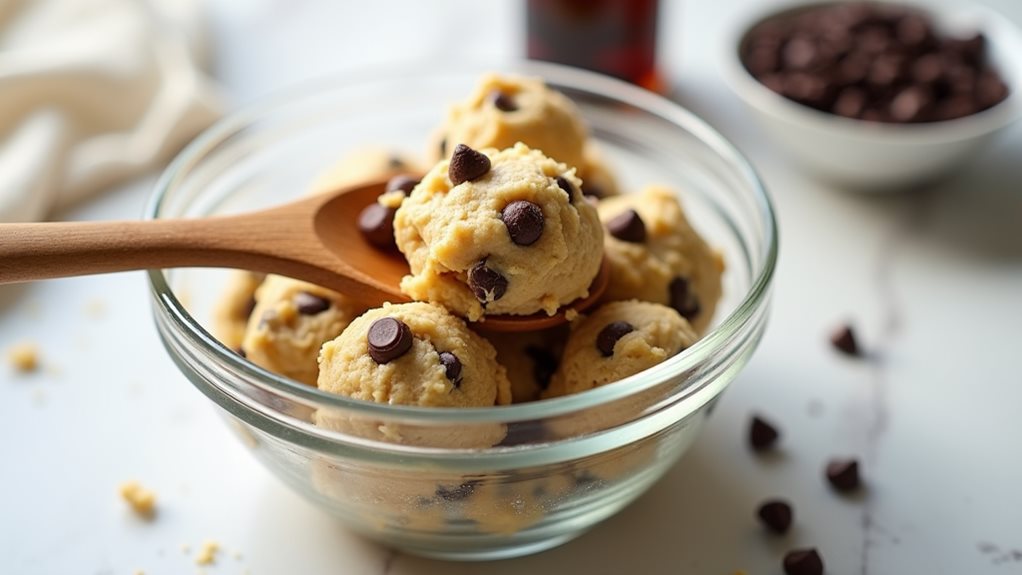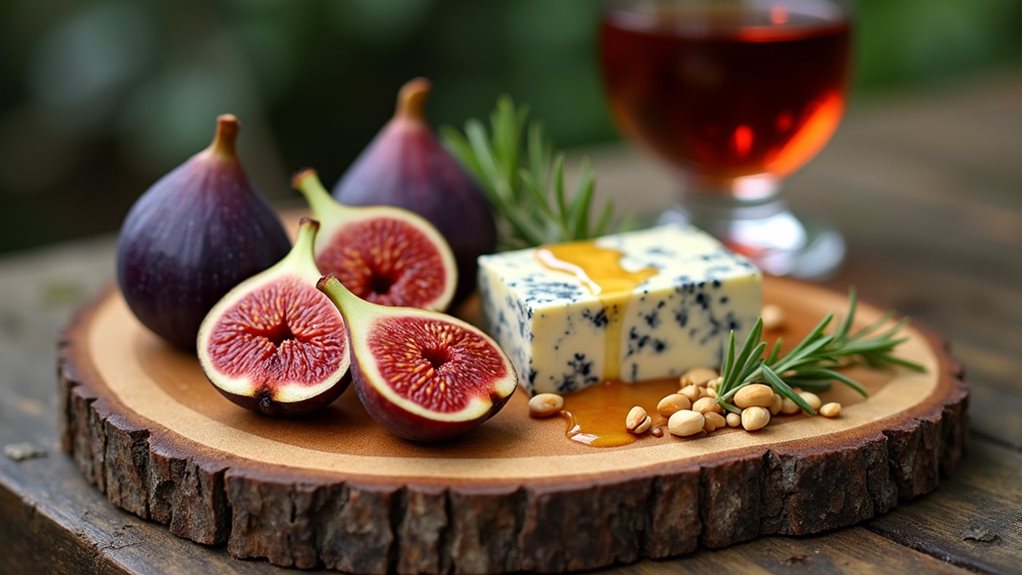Did you know that nearly 60% of Americans admit to eating raw cookie dough despite health warnings? You're not alone if you've ever snuck a spoonful of traditional cookie dough while baking, but there's a safer way to indulge in this guilty pleasure. Today's edible cookie dough trend has transformed from a risky habit into a legitimate dessert category, with dedicated shops popping up across major cities. Whether you're craving the nostalgic taste of childhood or looking to explore innovative flavor combinations, understanding how to make safe, edible cookie dough at home can open up a world of sweet possibilities.
Key Takeaways
- Edible cookie dough eliminates health risks by using heat-treated flour and no raw eggs while maintaining classic cookie dough taste.
- Heat-treat flour by baking at 350°F for 5-7 minutes before mixing to ensure safe consumption.
- Basic ingredients include butter, sugars, heat-treated flour, milk, vanilla, salt, and chocolate chips, mixed until light and fluffy.
- Store in an airtight container for up to one week in the refrigerator or freeze for three months.
- Use as a standalone treat, mix into ice cream, shape into truffles, or add as a topping for desserts.
History
Anyone familiar with baking has likely been tempted to snack on raw cookie dough while preparing cookies. For generations, parents and health officials have warned against this practice due to the risks associated with consuming raw eggs and untreated flour, but that hasn't stopped people from indulging in this guilty pleasure.
The concept of specifically crafted edible cookie dough emerged in the early 2010s when creative bakers and entrepreneurs recognized the market potential for a safe alternative to traditional raw dough. You'll find that the first dedicated cookie dough shops began appearing in major cities, with New York's DŌ, Cookie Dough Confections gaining significant attention in 2017.
The trend quickly spread across social media platforms, inspiring home bakers to develop their own egg-free, heat-treated flour recipes.
Today, you'll discover numerous commercial brands offering pre-packaged edible cookie dough in grocery stores, while many ice cream manufacturers have incorporated it into their flavor lineups. What was once considered a risky baking habit has transformed into a legitimate dessert category, complete with its own safety standards and preparation methods.
Recipe
Edible cookie dough has become increasingly popular as a safe alternative to traditional raw cookie dough, which contains raw eggs and untreated flour that could pose health risks. This version eliminates those concerns while maintaining the indulgent, nostalgic taste that makes people want to eat cookie dough straight from the bowl.
This recipe creates a creamy, sweet treat that can be eaten immediately or stored in the refrigerator for later enjoyment. The dough can be shaped into balls, used as an ice cream topping, or simply enjoyed by the spoonful. By heat-treating the flour and excluding eggs, this recipe provides a safe way to satisfy cookie dough cravings.
- 2 1/4 cups (280g) all-purpose flour
- 1 cup (227g) unsalted butter, softened
- 3/4 cup (150g) granulated sugar
- 3/4 cup (165g) packed brown sugar
- 1/4 cup (60ml) milk
- 2 teaspoons vanilla extract
- 1/2 teaspoon salt
- 1 cup (175g) chocolate chips
- 1/4 teaspoon baking soda
First, heat-treat the flour by spreading it on a baking sheet and baking at 350°F (175°C) for 5-7 minutes to kill any bacteria. Let it cool completely.
Cream together the softened butter and both sugars until light and fluffy. Add milk and vanilla extract, mixing until well combined. Gradually stir in the cooled flour, salt, and baking soda until thoroughly mixed. Fold in chocolate chips until evenly distributed throughout the dough.
To ensure the best results, make sure all ingredients are at room temperature before mixing. The dough can be stored in an airtight container in the refrigerator for up to one week. If the dough becomes too firm, let it sit at room temperature for 15-20 minutes before serving.
To prevent graininess, mix the sugars thoroughly with the butter, and avoid overmixing once the flour is added.
Cooking Steps
To create your edible cookie dough, you'll need to start by gathering all ingredients and measuring tools, ensuring everything is within arm's reach for a smooth preparation process.
Next, you'll cream softened butter and sugar together until light and fluffy, then mix in vanilla extract and gradually add milk until you achieve your desired consistency.
Finally, you'll gently fold in chocolate chips, distributing them evenly throughout the dough while being careful not to overmix, which could affect the texture of your finished treat.
Step 1. Gathering Ingredients and Tools
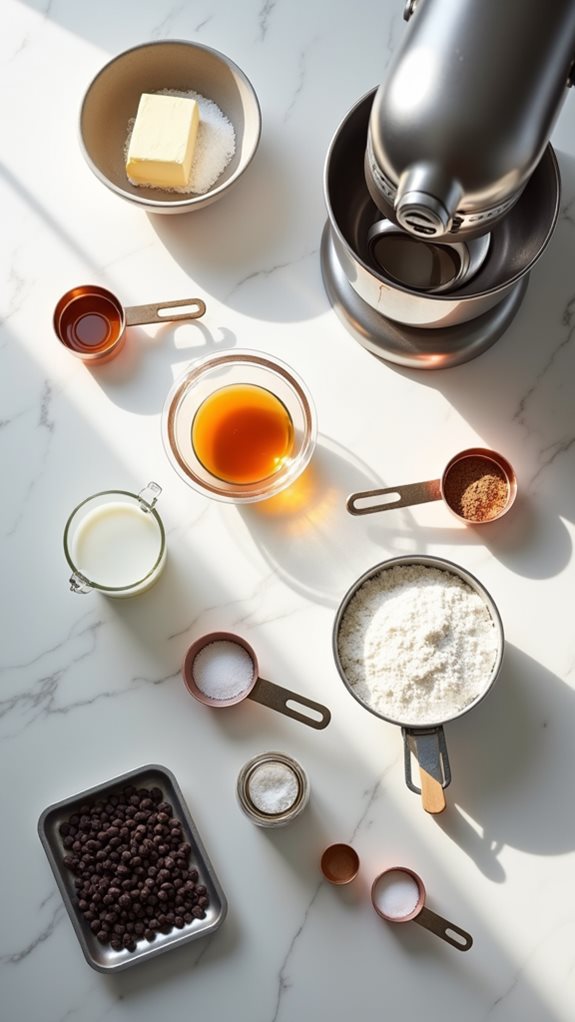
Before diving into the preparation, gather all your ingredients and tools onto a clean counter space. You'll need unsalted butter, brown sugar, granulated sugar, vanilla extract, milk, all-purpose flour, salt, and optional mix-ins like chocolate chips or sprinkles.
Don't forget to heat-treat your flour beforehand to eliminate any harmful bacteria.
For tools, you'll want to collect a large mixing bowl, measuring cups and spoons, a rubber spatula, and an electric mixer (though a whisk will work if you don't mind the extra effort).
Make sure you've got parchment paper or a baking sheet ready for the flour-treatment process, and keep a thermometer handy to verify the flour reaches 165°F during heat treatment.
If you're planning to store your cookie dough, grab an airtight container or plastic wrap.
Check that your butter's at room temperature before starting – this typically takes about 30 minutes on the counter.
While you're organizing, ensure all dairy products are fresh and your flour hasn't expired.
Having everything measured and ready will make the mixing process smooth and efficient.
Step 2. Cream Butter and Sugar Together
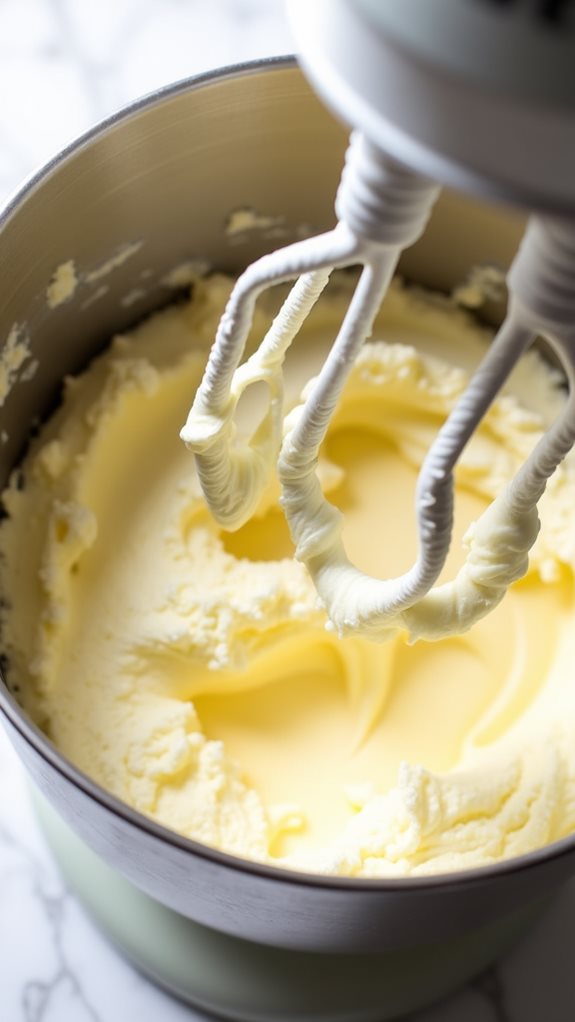
Now that your workspace is organized, let's start with the most important mixing step. You'll need to cream your softened butter and sugar together until the mixture becomes light and fluffy, which typically takes about 3-4 minutes using an electric mixer at medium speed. If you're mixing by hand, expect to spend 6-8 minutes achieving the right consistency.
Start by placing your room-temperature butter in the mixing bowl, ensuring it's soft enough that your finger can easily make an indent. Add both granulated and brown sugars according to your recipe's measurements.
As you begin mixing, you'll notice the color changing from dark to light golden, and the texture becoming increasingly airy. Don't rush this process, as proper creaming creates tiny air pockets that give your cookie dough its desired texture.
You'll know you've reached the right stage when the mixture clings to the sides of the bowl and has nearly doubled in volume. If you notice any unmixed butter chunks, continue beating until they're fully incorporated.
This crucial step sets the foundation for your entire cookie dough's structure and taste.
Step 3. Mix in Vanilla Extract
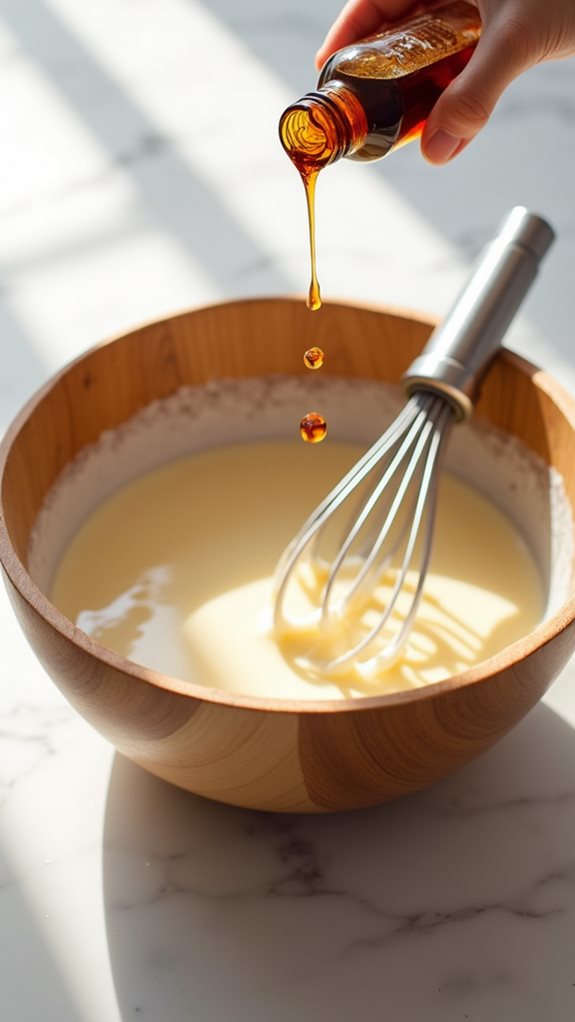
The recipe's next crucial addition, vanilla extract, enhances your cookie dough's depth of flavor. You'll want to measure one teaspoon of pure vanilla extract, ensuring you're using high-quality ingredients for the best results.
When you're adding the vanilla, pour it slowly into your creamed butter-sugar mixture while continuing to mix at medium speed.
As you incorporate the vanilla extract, you'll notice it brings a rich, aromatic quality that transforms your basic butter-sugar base into something more complex and inviting.
Don't rush this step – mix for about 30 seconds to ensure the vanilla is evenly distributed throughout the mixture. If you're using a stand mixer, you'll want to scrape down the sides of the bowl with a rubber spatula to ensure nothing's missed.
You can tell the vanilla's properly incorporated when the mixture has a uniform color and you don't see any dark streaks of extract.
At this stage, your dough base should be smooth and well-blended, with a noticeable vanilla fragrance that'll carry through to your finished cookie dough.
This step creates the foundation for the signature cookie dough flavor you're aiming to achieve.
Step 4. Add Milk for Consistency
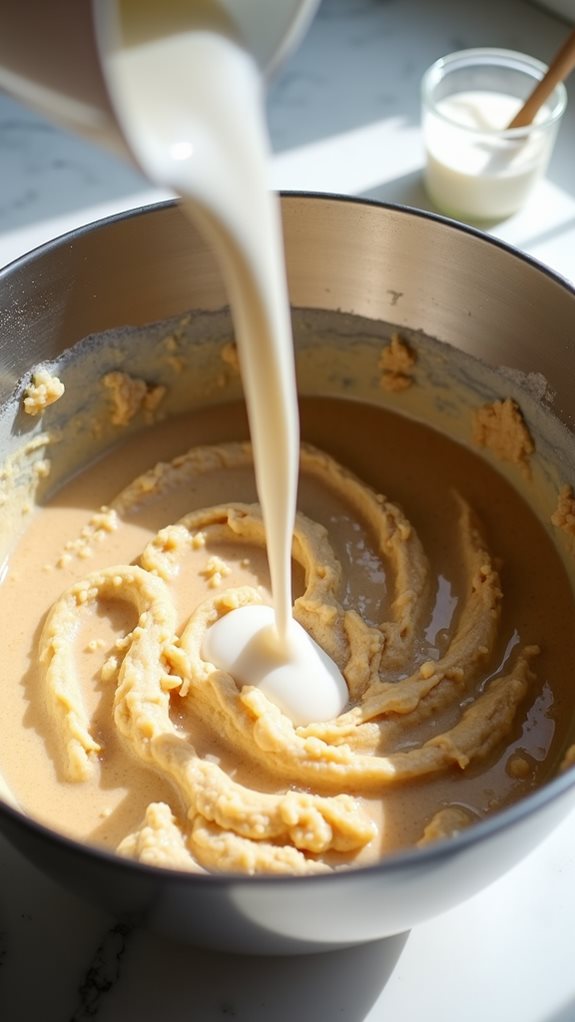
With your vanilla-infused mixture ready, you'll need to adjust the consistency by adding milk. Start by adding one tablespoon of milk at a time, thoroughly incorporating each addition before evaluating the texture. You're aiming for a consistency that's smooth and easily scoopable, but not too runny or wet.
As you add the milk, you'll notice the dough becoming more pliable and easier to work with. The ideal texture should allow you to form the dough into balls that hold their shape while remaining soft enough to scoop.
If you've added too much milk and the dough becomes too wet, you can balance it by incorporating small amounts of flour, about a teaspoon at a time, until you achieve the desired consistency.
Remember that different factors, including room temperature and ingredient variations, can affect how much milk you'll need. Generally, you shouldn't need more than 3-4 tablespoons total for a standard batch.
Take your time with this step, as the right consistency will significantly impact the final texture of your edible cookie dough.
Step 5. Fold in Chocolate Chips

Once your dough reaches the perfect consistency, gently fold in 1 cup of chocolate chips using a rubber spatula or wooden spoon.
Work the chocolate chips into the dough using a folding motion, lifting from the bottom and bringing the dough over the top, rather than stirring in circles. This technique helps prevent the chips from breaking and ensures they're evenly distributed throughout your cookie dough.
You'll want to use semi-sweet chocolate chips for the classic cookie dough taste, though you can experiment with different varieties like milk chocolate, dark chocolate, or even mini chips for a more delicate texture.
If you're working with room temperature dough, you might notice the chips starting to melt slightly – that's perfectly fine and will contribute to the authentic cookie dough experience.
Don't overmix once you've added the chips, as excessive folding can cause them to break down and create streaks in your dough.
When you can see chips evenly scattered throughout the mixture, you'll know you've folded them in properly.
Final Thoughts
Making edible cookie dough from scratch lets you enjoy the nostalgic taste of raw cookie dough without any health risks.
You'll discover that this safe-to-eat version delivers all the comfort and satisfaction of traditional cookie dough while eliminating concerns about raw eggs and untreated flour.
Store your homemade edible cookie dough in an airtight container in the refrigerator, where it'll stay fresh for up to one week.
If you're planning to keep it longer, you can freeze portions for up to three months. When you're ready to enjoy it again, simply let it thaw in the refrigerator overnight.
Don't limit yourself to just eating it straight from the bowl – you can incorporate this treat into other desserts.
Try rolling it into balls for cookie dough truffles, mixing it into ice cream, or using it as a topping for brownies and cakes.
You'll find that making your own edible cookie dough isn't just safer than eating raw cookie dough, it's also more versatile and can be customized with your favorite mix-ins and flavors.

